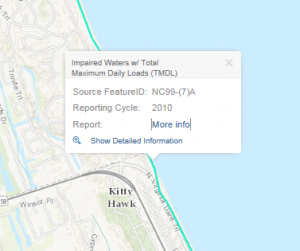DWMAPs: Showing the Way to Cleaner Water
By Mary Schollhamer
Growing up, I have always been a big fan of outdoor activities and enjoyed spending time at the beach with my family. The ocean was a big part of our lives, whether we were fishing, swimming, or on my grandfather’s boat. Now that I have a family of my own, we pack the car and the dog and head to the Outer Banks on the coast of North Carolina.
spending time at the beach with my family. The ocean was a big part of our lives, whether we were fishing, swimming, or on my grandfather’s boat. Now that I have a family of my own, we pack the car and the dog and head to the Outer Banks on the coast of North Carolina.
This summer, as my family was playing in the shallow tide and my dog was chasing crabs, I asked myself, “Is my family safe?”
Last month, EPA released a new tool to answer my question: the Drinking Water Mapping Application to Protect Source Waters (DWMAPS). DWMAPs is an online mapping tool to help you find information about drinking water and surface water in your community. I zoomed the map into the beach near Kitty Hawk, NC and added a layer of data to tell me if there were any existing Total Maximum Daily Loads (TMDLs) for these waters. A TMDL is a calculation of the maximum  amount of a pollutant that can occur in a water body and serves as a potential starting point for restoration and maintaining water quality standards. The map provided links to location-specific reports, one of which told me the only problem I should be concerned about is the high-level of mercury in the fish caught in this area. The DWMAPS tool is very informative and great for helping to protect your family and pets from harmful substances.
amount of a pollutant that can occur in a water body and serves as a potential starting point for restoration and maintaining water quality standards. The map provided links to location-specific reports, one of which told me the only problem I should be concerned about is the high-level of mercury in the fish caught in this area. The DWMAPS tool is very informative and great for helping to protect your family and pets from harmful substances.
While DWMAPs is an easy way to find out about sources of pollution near your drinking water or how to get involved in protecting sources of drinking water in my community, it’s also a great tool for drinking water professionals. DWMAPs can be used to identify potential sources of contamination in specific locations, find data to support source water assessments, and help implement plans to manage potential sources of contamination. The new tool can also evaluate accidental spills and releases, identifying where emergency response resources for accidental releases must be readily available, and promote integration of drinking water protection activities with other environmental programs at the EPA, state, and local levels.
For information about what you can do to help, visit DWMAPs and click “What Can I Do About It?”
About the author: Mary Schollhamer is the Acting Deputy Director of Communications in the Office of Water. She holds a Master’s Degree in English with a focus on ecofeminism from Stony Brook University and loves dogs.
